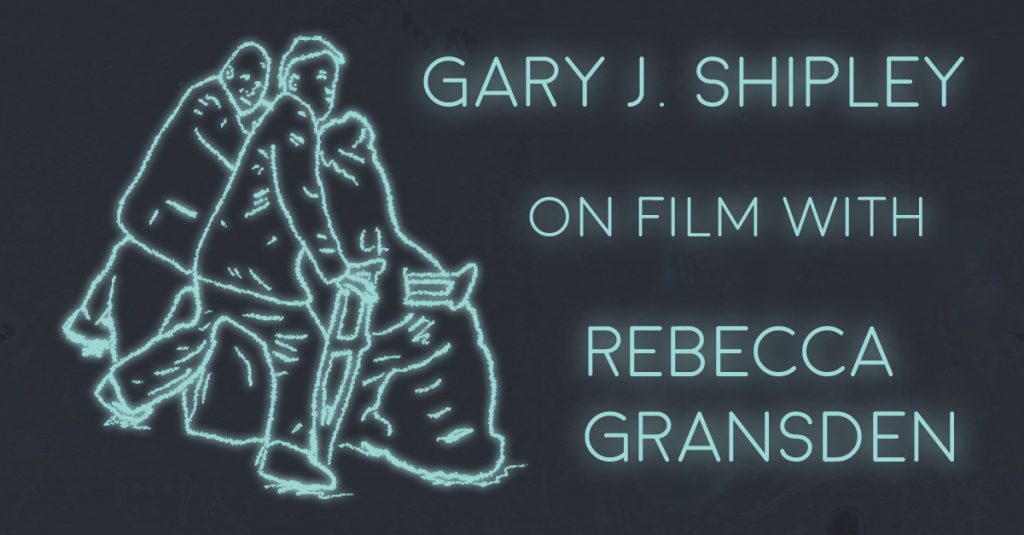Rebecca Gransden: Your work explores extremity. Extremity of violence yes, and also conceptual extremity, extremity in language use, of idea. I instinctually back away from inquiry into direct influence, seeing it as reductive, although I have noticed trends among artists. To some, influence is a question of attraction to work reflective of, or in kinship with, their work, and to others influence exists as an energising feedback loop. With that in mind, how do you view extremity in cinema and, by extension, its relationship with and influence on your writing?
Gary J. Shipley: Yes, “conceptual extremity” and “extremity in language” are very much the focus for me. The violence is often a means to reinforce, or probe, or otherwise explain, what for me is a conceptual or linguistic problem. In The Unyielding, for instance, the body horror is always permeated by the abstract in order to establish and sustain the immovable wife’s paradoxical being. With extremity in cinema, I suppose I’m invariably trying to see into/through/around it in the same way. But often when films are described as extreme, that’s not my experience: I mean, who are these people still so ripe for shock and umbrage? Nekromantik segues into The Wizard of Oz into The Golden Glove into Sir Henry at Rawlinson End into Angst into My Dinner With Andre into The Poughkeepsie Tapes into Swoon into She’s Allergic to Cats into I Stand Alone and who’s to say who’s going too far, and who fucking cares to listen? Losing your virginity to a warm turd might be considered a trifle immoderate, but then there’s always Sade-the-philosopher at work in the background. I think the notion of extremity in the arts is mostly overblown and outmoded anyway. It’s nothing we’re not daydreaming about in the shower, or somebody somewhere isn’t doing in their bedroom or basement, nothing some poor sod isn’t enduring, or someone else getting off on. What about that video of a puppy being fed to a snake, the footage of industrial farming, the Dog Meat Festival in Yulin…? Violence and extreme cruelty are everywhere, nothing new; it’s the way we gloss over them that’s often extreme to me, and repellent, and potentially dangerous (and therefore interesting).
RG: Repetition and simulation feature prominently in Terminal Park, 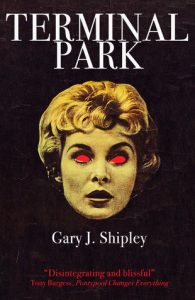 where you utilise the reenactment of an iconic scene from cinema history, a scene that has been the subject of reinterpretation multiple times and ways. Could you expand upon this choice and your intentions with regard to artistic discourse when it comes to the mutation of meaning inherent in exploration of this kind?
where you utilise the reenactment of an iconic scene from cinema history, a scene that has been the subject of reinterpretation multiple times and ways. Could you expand upon this choice and your intentions with regard to artistic discourse when it comes to the mutation of meaning inherent in exploration of this kind?
GJS: The Psycho shower scene’s ubiquity and theoretical baggage were essential, with so many useful resources to draw on. Aside from all the Hitchcock plums, you’ll no doubt spot a fair few others as well: Funeral Parade of Roses, Dogville, Body Double… Anyway, I’m clearly playing with some well-trodden ideas in Baudrillard and Deleuze. As Norwegian artist Nikolas Berg puts it in the book, albeit borderline delirious at this point: “Copying feeds on itself and once started can never be finished; and as all moments already exist so too do all copies, and there are perfect copies and less than perfect copies, each again copied regardless of fidelity to their originals, and so the space for original creation shrinks and grows at the same time: to zero on one level and to everything that could ever possibly exist on the other. […] But difference on this model is decay, and it has a long history, and is heading in only one direction: outward and outward to the moment of (self-referential) rupture.” I’d already written my book on Baudrillard, Stratagem of the Corpse: Dying With Baudrillard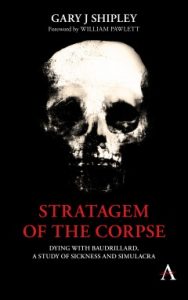 , when I wrote Terminal Park, so I had his body of work acting as a kind of lens. But then I’ve also long enjoyed exploring films with the same narrative core: Wages of Fear/Sorcerer, Le Feu Follet/Oslo, August 31st, all the many takes on Crime and Punishment, from Fear to the brilliant Norte: The End of History, etc. I remember when reading HHhH how when Binet lists all the different film versions there have been about Operation Anthropoid (the events surrounding the assassination of Heydrich), I’d already seen them all. Not that I’d done anything with it. Just for the joy of comparing the different approaches, you know. And then I got the film adaptation of that, so there was another one. There’s Synecdoche, New York as well, which is a film I admire and probably played a part on some level. And The Exterminating Angel, which is always lurking somewhere. I’m also fascinated by the kind of paranoid pattern building that, while respectful of the facts, imposes some speculative and warped order – the kind you see in, to take a recent example, Under the Silver Lake.
, when I wrote Terminal Park, so I had his body of work acting as a kind of lens. But then I’ve also long enjoyed exploring films with the same narrative core: Wages of Fear/Sorcerer, Le Feu Follet/Oslo, August 31st, all the many takes on Crime and Punishment, from Fear to the brilliant Norte: The End of History, etc. I remember when reading HHhH how when Binet lists all the different film versions there have been about Operation Anthropoid (the events surrounding the assassination of Heydrich), I’d already seen them all. Not that I’d done anything with it. Just for the joy of comparing the different approaches, you know. And then I got the film adaptation of that, so there was another one. There’s Synecdoche, New York as well, which is a film I admire and probably played a part on some level. And The Exterminating Angel, which is always lurking somewhere. I’m also fascinated by the kind of paranoid pattern building that, while respectful of the facts, imposes some speculative and warped order – the kind you see in, to take a recent example, Under the Silver Lake.
RG: There is forensic clarity to your writing, an observational quality that can be as repellent as it is fascinating. When it comes to form, how much of your style is a consequence of natural aptitude and how much calculated to serve your intention for the text?
GJS: Form is crucial to my work, has been from the start. My first book, Theoretical Animals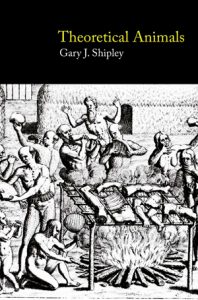 , depicts a world of abstracted cannibalism and cannibalises itself as it does so. This autocannibalisation involves the second half of the book having the exact same letters as the first half, with each section from the second half rearranging the same letters as its corresponding section in the first half. Or Necrology (written with Kenji Siratori) where the structure mirrors a torture method used by Etruscan pirates. With Terminal Park, one of the most obvious formal influences is the extreme shift in focus (from the fission apocalypse to the “PsychoBarn”) that occurs approximately one third in, as it does in Psycho. And like the film, we move from the exterior to the interior. The other books I’ve written that have been most formally influenced by cinema would be 30 Fake Beheadings
, depicts a world of abstracted cannibalism and cannibalises itself as it does so. This autocannibalisation involves the second half of the book having the exact same letters as the first half, with each section from the second half rearranging the same letters as its corresponding section in the first half. Or Necrology (written with Kenji Siratori) where the structure mirrors a torture method used by Etruscan pirates. With Terminal Park, one of the most obvious formal influences is the extreme shift in focus (from the fission apocalypse to the “PsychoBarn”) that occurs approximately one third in, as it does in Psycho. And like the film, we move from the exterior to the interior. The other books I’ve written that have been most formally influenced by cinema would be 30 Fake Beheadings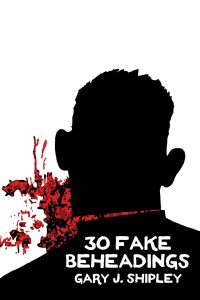 and You With Your Memory are Dead. With the former, it all started when Rauan Klassnik put the germ in my head (with his idea that I review some unseen films for a magazine he was co-editing) and I couldn’t get it out. But I needed the films to be rooted in the existing reality of the unreal, and so the concocted films, I felt, had to be sequels. And what better way to reinforce the violence of the encounter than by inventing sequels for films that actively militated against that possibility. The book draws on decapitation theory and the post-cephalic nature of the cinematic experience, so it came as no real surprise that documenting the viewer (and his escalating absence to himself) quickly became as important as documenting the invented film itself. And the two fed on each other. “Antichrist 2” was the first in this decollative sequence, but the viewer demanded more and more cuts, and being obliging I obliged. YWYMAD is the result of watching Begotten on a loop for two weeks: ekphrastic writing as ritual, if you like. Warewolff! would be another example of my attempting to marry language-play and formal concept. If we think in terms of invisible forms (à la Kevin Jackson), even the title
and You With Your Memory are Dead. With the former, it all started when Rauan Klassnik put the germ in my head (with his idea that I review some unseen films for a magazine he was co-editing) and I couldn’t get it out. But I needed the films to be rooted in the existing reality of the unreal, and so the concocted films, I felt, had to be sequels. And what better way to reinforce the violence of the encounter than by inventing sequels for films that actively militated against that possibility. The book draws on decapitation theory and the post-cephalic nature of the cinematic experience, so it came as no real surprise that documenting the viewer (and his escalating absence to himself) quickly became as important as documenting the invented film itself. And the two fed on each other. “Antichrist 2” was the first in this decollative sequence, but the viewer demanded more and more cuts, and being obliging I obliged. YWYMAD is the result of watching Begotten on a loop for two weeks: ekphrastic writing as ritual, if you like. Warewolff! would be another example of my attempting to marry language-play and formal concept. If we think in terms of invisible forms (à la Kevin Jackson), even the title 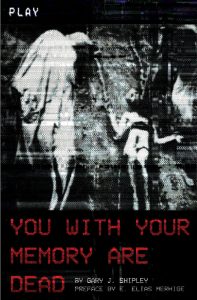 of W sucked more energy than maybe it should have. To briefly explain: in Finnegans Wake, “warewolff!” (beware wolf) is what the Floras or the Maggies shout to Glug (or Shem), who is the wolf of which we should beware. Glugg fails to see what is hidden (cannot guess the colour of Issy/Izod’s knickers) so becomes hidden, is sent into exile. He is akin to the devil, is self-absorbed and self-absorbing (“he make peace in his preaches and play with esteem”), can only answer the riddle if he can see himself in his entirety (Shem/Glugg and Shau
of W sucked more energy than maybe it should have. To briefly explain: in Finnegans Wake, “warewolff!” (beware wolf) is what the Floras or the Maggies shout to Glug (or Shem), who is the wolf of which we should beware. Glugg fails to see what is hidden (cannot guess the colour of Issy/Izod’s knickers) so becomes hidden, is sent into exile. He is akin to the devil, is self-absorbed and self-absorbing (“he make peace in his preaches and play with esteem”), can only answer the riddle if he can see himself in his entirety (Shem/Glugg and Shau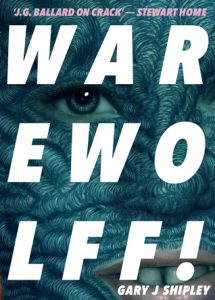 n/Chuff) but cannot bear to do it, is ugly and foul-mouthed, the banished “bold bad bleak boy of the storybooks,” and a language tutor to boot, making it only fitting that when he sneaks back for revenge it is through language that he is revealed: a mocking bard (“mocking birde to micking barde”). Then there’s then all the D&G stuff about becoming-wolf: located at the edge but not outside society, a multiplicity, a hole, a formless form… Anyway, given how perfectly all this aligns with the “creature” in/as the book, it soon became the only title I could imagine.
n/Chuff) but cannot bear to do it, is ugly and foul-mouthed, the banished “bold bad bleak boy of the storybooks,” and a language tutor to boot, making it only fitting that when he sneaks back for revenge it is through language that he is revealed: a mocking bard (“mocking birde to micking barde”). Then there’s then all the D&G stuff about becoming-wolf: located at the edge but not outside society, a multiplicity, a hole, a formless form… Anyway, given how perfectly all this aligns with the “creature” in/as the book, it soon became the only title I could imagine.
RG: Your work investigates destruction, whether this is bodily, symbolic, or cultural. With the focus on collapse, and a disintegrating force, your writing often has a desensitising effect. Do you actively use desensitisation for its own sake or do you view your work as in dialogue with it? With this in mind are there examples of desensitisation in cinema that resonate with you or your work?
GJS: That desensitising effect is less a conscious technique and more an honest reflection of where I’m writing from: a felt distance, an unwillingness to participate in so many of the prevalent fabrications of identity. Destruction is not the issue for me, only suffering. And from here to the meaninglessness of suffering (and of meaning itself), and therein a possibility for meaning as esoteric and fervid as it is ruinous. The first film that comes to mind is Peeping Tom, where the desensitisation is itself deeply felt. It’s also there in the work of Lars von Trier and Yorgos Lanthamos, for example. And in Spoorloos, Funny Games, The White Ribbon, and on and on. If you want a film that might just destroy you a little bit (even with everything they had to leave out), try the short Detainment.
RG: As a secular form of Apocalypticism has taken hold in culture, end of the world tropes are more than cliché, but normalised. Do you consider your work to be in dialogue with this trend? Are there examples of apocalyptic cinema you see as particularly successful in reflecting this?
GJS: As I make clear in Terminal Park, the apocalypse is a disclosure, a revealing of something formerly hidden. And while this harps back to its religious origins, it is still present in the secularised versions you mention, and in the best examples of apocalyptic art, literature and film. It is this end as revelation that I find interesting. Not the tired notion of environmental and societal collapse exposing the best and worst of human nature (which is only a faux reveal, I mean who didn’t know this already?) that is the focus of so much mainstream work, but a true reveal of something truly hidden: a seismic shock, a jolt, a complete and utter mindfuck. I also don’t think you can get away from the salvationist implications of this gap.
RG: One area of your work that is especially striking is your representation of the body. Whether objectified, idolised, annihilated, or deconstructed, the body glistens in all its glory. Your work acknowledges the seduction of transgressing fleshly boundaries. Do you take inspiration from body horror in cinema?
GJS: It’s there, of course, along with those from literature and art. And sometimes it’s direct, but more frequently the influence is oblique. There are the usual, I guess, scenes/images that set up home in your head and never leave: the nefarious matter, the stuffs and blobs, the mergings, augmentations and depletions, and the usual cinematic touchstones (Lynch, Cronenberg, Carpenter…), and those scenes implanted in me (and many others) for good, from films as various as Possession, Bug, Tetsuo: The Iron Man, The Human Centipede, Un Chen Andalou, Fiend Without a Face, Blood of the Beasts, and on and on. And I wonder if I ever really escaped those Nightmare on Elm Street films that I lapped up as a kid? Or the Hellraiser, Exorcist, Omen, Evil Dead, Alien franchises? And here comes Udo Kier choking on whore blood and scissoring off a human head. Outside of cinema, Francis Bacon’s the master, and Lispector’s cockroach is my kind of madeleine. And yes, my daydreams are the kind where Charters and Caldicott turn up in Trash Humpers bleating about sandwich fillings, checking cricket scores, vigorously shagging refuse.
RG: Part of what makes your work compelling to read is the sense of being pulled in a certain direction, only to encounter a series of wild juxtapositions. As soon as there is philosophical underpinning, there is a turn to the visceral and experiential, and the alienating and cerebral is punctuated by stark and searing images, often captured in one sentence. Your use of imagery is vivid and electric. Do you see an equivalent in cinema? Does the structure of film have any bearing on your style?
GJS: Cinematic techniques definitely seep in. They’ve doubtless permeated my experience of the world so thoroughly they’d be hard to escape. But then it’s also worth remembering that a lot of these techniques were already there in literature, so it’s in no way exclusively cinematic. I suppose you’re referencing jump cuts or rack focusing, or montage, double/multiple exposures, whatever, which are all over the place. The challenge is to do it without them looking like clunky/inferior versions of their cinematic cousins.
RG: Returning to Terminal Park, I see the glacial intellectualism that characterises some conceptual art, directly invoked by the strange and initially abstruse reenactment that takes centre stage for some sections. Do you make a clear distinction between the use of conceptual art inside the narrative and the narrative itself as a form of conceptual art, or are these lines blurred, non-existent, or for the reader to decide?
GJS: The hope is that they become blurred. Lynch, like Tarkovsky and others before him, wanted to make paintings that moved (which of course he did quite literally in his early shorts), and we see the narrational and visual freedom this affords him; but it’s also there in the detached and sombre weirdness of Roy Andersson’s films, in which everything feels so staged and abiotic that the movement itself becomes a kind of aberration. And then there are the less integrated uses, seen recently in films such as Velvet Buzzsaw, Paint, or The Burnt Orange Heresy. Anyway, what I’m trying to say is that there are many ways that writing and art can intersect. For instance, Serial Kitsch (an epic poem I made from the appropriated words of serial killers) was one way of attempting this, and “The Mutant” (which merged the cerebral and abstract practice of creating a work of conceptual art with the artist’s brain cancer) was another. Actually, the novel I’ve just finished revolves around three uncharacteristically dark paintings by René Magritte, so on it goes.
(an epic poem I made from the appropriated words of serial killers) was one way of attempting this, and “The Mutant” (which merged the cerebral and abstract practice of creating a work of conceptual art with the artist’s brain cancer) was another. Actually, the novel I’ve just finished revolves around three uncharacteristically dark paintings by René Magritte, so on it goes.
RG: From its origins cinema has illuminated by illusion. What place does art and artifice have in your work? In a time of immense media and information saturation and film as a medium grapples with its context, do you see the density of your work as a response to or reflection of this shift?
GJS: It is central, inescapable. It puts me in mind of Baudrillard’s quip about AI, how because it lacks artifice it therefore lacks intelligence. Or as Lisa Robertson puts it: “artifice is the soul.” Works of realism that are supposedly free of artifice, as if that amounts to some badge of honour, that’s where the contrivance is. Which in itself needn’t be a bad thing, although it all too frequently is. The prodigiously trite as authentic lived experience is quite the gilded shit right now.
RG: Returning to destruction and decay, is it necessary for the screen itself to break down? Should celluloid self-destruct?
GJS: The screen breaks down all the time, it’s the default. The hard thing is to see the screen. And once you’ve seen it, to stop seeing it.
RG: If you could give some recommendations for films that would be enjoyed by those who are fans of your writing that would be great.
GJS: I watch 1-2 films a day, most days, have done for a lot of years now, so if I may I’ll pick in no order from the films rewatched in the last month or so that these fans, if you can ever reach such recherché phenomena, might well enjoy:
A Dark Song, Simon Killer, Tony, Saint Maud, Escape From Tomorrow, The Shout, La femme infidèle, Le Boucher, The Transfiguration, The Night Eats the World, L’humanité, Twentynine Palms, Downloading Nancy, My Heart Can’t Beat Unless You Tell It To, These are the Damned, Uzak, Personal Shopper, Most Beautiful Island, Upstream Color, I Blame Society, Apartment Zero, Possessor, Burning, In the Earth, Alphaville, Bad Timing, Providence…

